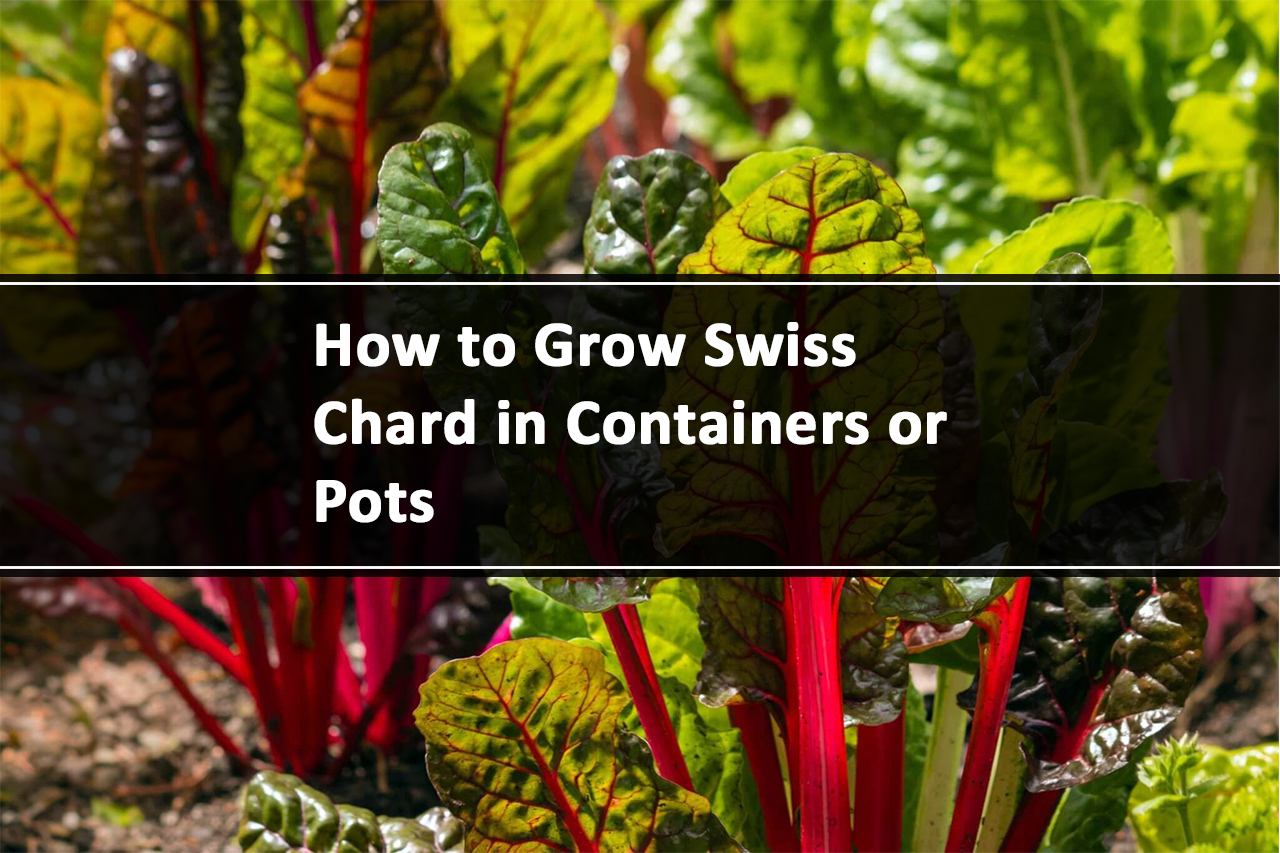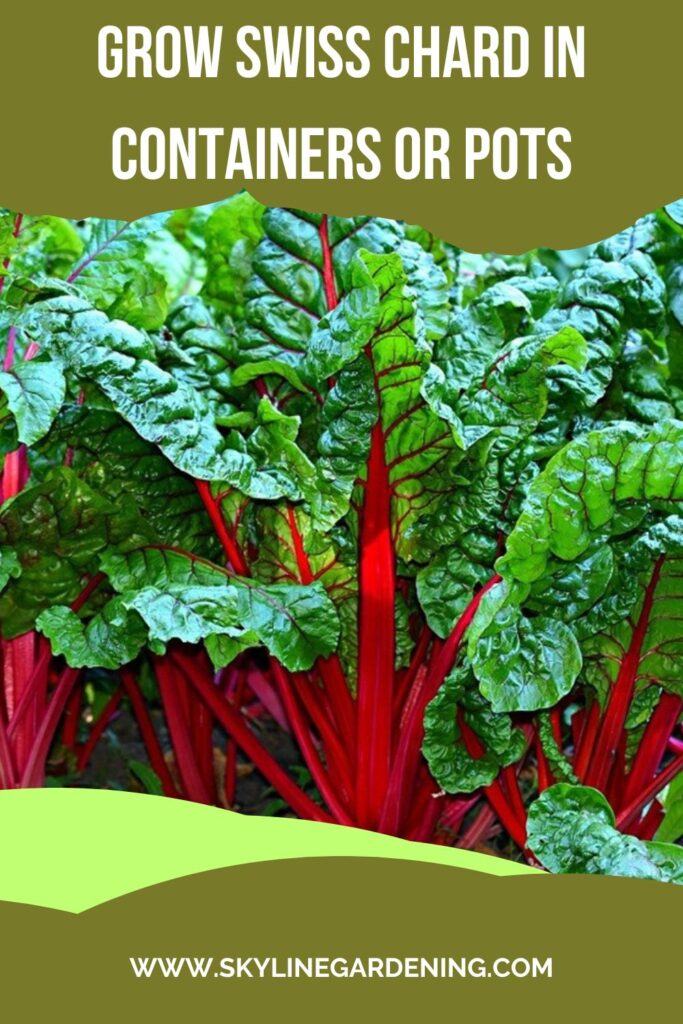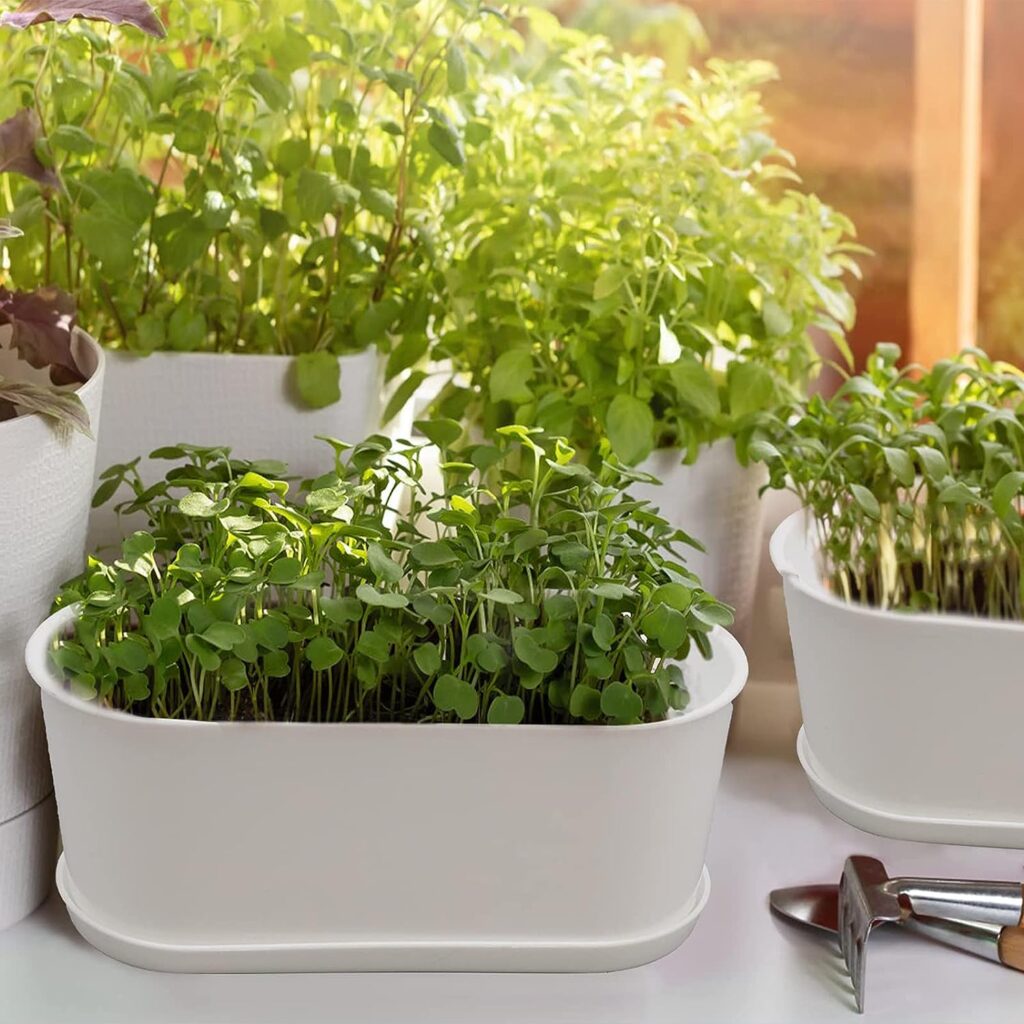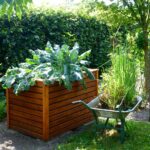Beautiful Plants For Your Interior

How to Grow Swiss Chard in Containers or Pots
In the world of container gardening, one vegetable that shines with its vibrant colors and nutritious benefits is Swiss chard. If you’ve ever wondered how to grow Swiss chard in containers, you’ve come to the right place.
Container gardening is a versatile and accessible way to grow fresh produce, even if you have limited space. Swiss chard, with its leafy greens and rainbow-colored stems, is an excellent addition to any container garden. Whether you’re a seasoned gardener or a novice with a green thumb, you’ll find valuable insights in this blog post to help you nurture and harvest this nutritious green from the comfort of your own home. So, let’s get started on your journey to grow Swiss chard in containers!

Before you dive into the world of Swiss chard container gardening, you need to choose the right container. The container you select plays a crucial role in the success of your Swiss chard crop. Here are some key factors to consider:
Container Size: Swiss chard has a deep root system, so opt for containers that are at least 12 inches deep and 12-18 inches wide. This will provide enough space for the roots to grow and prevent overcrowding.
Material: Containers come in various materials, including plastic, ceramic, and wood. Ensure that the container you choose is durable, has proper drainage holes, and is suitable for outdoor use.
Drainage: Proper drainage is essential to prevent waterlogged soil, which can lead to root rot. Make sure your container has adequate drainage holes at the bottom.
Mobility: Consider the weight of the container when filled with soil. If you plan to move your Swiss chard around, choose a container that has wheels or is lightweight enough for you to handle.
Aesthetic Appeal: Container gardening allows you to get creative with your choices. Pick a container that complements your outdoor space or adds visual interest to your garden.

Swiss Chard Containers for Urban Garden
Oval Garden Planter with Multiple Holes or for indoor Grow Plants, Flowers, and Succulents
Choosing the Right Soil Mix
Swiss chard thrives in well-draining soil rich in organic matter. When growing Swiss chard in containers, it’s crucial to choose the right soil mix to provide the necessary nutrients and moisture retention. Here’s what you need to know:
Potting Mix: Use a high-quality potting mix designed for container gardening. These mixes are specifically formulated to provide good drainage and aeration.
Organic Matter: Swiss chard benefits from soil rich in organic matter. You can improve the soil by adding compost or well-rotted manure to the potting mix. This will enhance fertility and water retention.
pH Level: Swiss chard prefers slightly acidic to neutral soil with a pH range of 6.0 to 7.0. You can test the pH of your soil using a pH testing kit and make necessary adjustments with lime or sulfur.
Fertilization: Consider using a balanced, slow-release fertilizer to ensure your Swiss chard receives a consistent supply of nutrients throughout its growing season.
Planting Swiss Chard Seeds or Transplants
Now that you have your container and soil mix ready, it’s time to plant your Swiss chard. You have two options: planting seeds or using transplants.
Planting Swiss Chard Seeds
Seed Depth: Plant Swiss chard seeds about 1/2 inch deep in the soil. Space the seeds 2-3 inches apart in rows or scatter them evenly across the container.
Thinning: Once the seedlings emerge, thin them to maintain a spacing of 4-6 inches between plants. This prevents overcrowding and promotes healthy growth.
Germination Temperature: Swiss chard seeds germinate best in soil temperatures between 50°F and 85°F (10°C to 29°C). Use a soil thermometer to monitor temperatures.
Watering: Keep the soil consistently moist but not waterlogged. Water gently to avoid disturbing the seeds.
Using Swiss Chard Transplants
Purchase or Prepare Transplants: You can buy Swiss chard transplants from a garden center or start your own indoors using seeds. Transplants should have 2-4 leaves before you transplant them.
Planting Depth: Plant transplants at the same depth they were in their original containers. Space them 4-6 inches apart.
Careful Handling: Handle transplants carefully to avoid damaging the roots and leaves during the planting process.
Providing the Right Growing Conditions
Swiss chard requires specific growing conditions to thrive. Here’s how to ensure your container garden provides the ideal environment:
Sunlight: Swiss chard loves sunlight. Place your container in a location where it receives at least 6-8 hours of direct sunlight daily.
Watering: Keep the soil consistently moist, but avoid overwatering, as it can lead to root rot. Water deeply when the top inch of soil feels dry to the touch.
Mulching: Apply a layer of organic mulch, such as straw or shredded leaves, to help retain soil moisture and regulate temperature.
Temperature: Swiss chard is a cool-season crop and thrives in temperatures between 50°F and 75°F (10°C to 24°C). It can tolerate light frost but may bolt (produce flowers and seeds) in extreme heat.
Maintaining Your Swiss Chard Container Garden
To ensure a successful Swiss chard harvest, regular maintenance is key. Here are essential tasks to keep your container garden thriving:
Fertilization: Swiss chard benefits from a mid-season boost of fertilizer. Use a balanced, water-soluble fertilizer and follow the package instructions.
Pest and Disease Management: Keep an eye out for common pests like aphids and cabbage worms. Remove them by hand or use organic pest control methods. Also, be vigilant for signs of disease and treat promptly.
Harvesting: Swiss chard leaves can be harvested as soon as they reach a desirable size, typically 6-8 inches long. Use scissors or pruning shears to cut the outer leaves, allowing the inner leaves to continue growing.
Successive Planting: Extend your Swiss chard harvest by planting new seeds or transplants every few weeks. This ensures a continuous supply of fresh greens.
Harvesting and Enjoying Your Swiss Chard
The reward for your hard work is a bountiful harvest of Swiss chard. Harvesting and enjoying this versatile green is the culmination of your container gardening journey.
Harvesting Technique: When harvesting Swiss chard, cut the outer leaves near the base of the stem. Leave the inner leaves to continue growing. This allows the plant to produce more leaves for future harvests.
Storage: Store harvested Swiss chard in a plastic bag or container in the refrigerator. It can stay fresh for up to a week when stored properly.
Cooking and Recipes: Swiss chard is incredibly versatile and can be sautéed, steamed, added to soups, or used in salads. Its mild, slightly earthy flavor complements a variety of dishes.
Nutritional Benefits: Swiss chard is rich in vitamins A, K, and C, as well as minerals like magnesium and potassium. It’s a low-calorie, nutrient-dense addition to your diet.
How to Grow Swiss Chard in Containers From Seed?
Growing Swiss chard in containers from seeds is a rewarding and relatively straightforward process. Here’s a step-by-step guide to help you successfully grow Swiss chard in containers from seed:
Gather Your Supplies:
- Container: Choose a container that is at least 12 inches deep and 12-18 inches wide. Make sure it has drainage holes at the bottom.
- Soil: Use a high-quality potting mix that is well-draining and rich in organic matter.
- Seeds: Purchase Swiss chard seeds from a reliable source.
Planting the Seeds:
- Fill the Container: Fill the container with the potting mix, leaving about an inch below the rim.
- Sow the Seeds: Plant Swiss chard seeds about 1/2 inch deep in the soil. Space the seeds 2-3 inches apart in rows or scatter them evenly across the container.
- Cover and Water: Gently cover the seeds with a thin layer of soil and water the container thoroughly. Ensure the soil remains consistently moist during the germination period.
Germination and Early Care:
- Warmth and Light: Place the container in a warm location with indirect sunlight. Swiss chard seeds germinate best in soil temperatures between 50°F and 85°F (10°C to 29°C).
- Thin the Seedlings: Once the seedlings emerge and develop their first true leaves, thin them to maintain a spacing of 4-6 inches between plants. Remove the weaker seedlings, allowing the stronger ones to grow.
Care and Maintenance:
- Sunlight: Move the container to a sunny spot where the Swiss chard can receive at least 6-8 hours of direct sunlight daily. If indoors, use grow lights to supplement sunlight.
- Watering: Keep the soil consistently moist. Water the container when the top inch of soil feels dry to the touch. Avoid waterlogging, as it can lead to root rot.
- Fertilization: Swiss chard benefits from a balanced fertilizer. Apply a water-soluble fertilizer every 2-3 weeks to ensure the plants receive necessary nutrients.
- Thinning (If Necessary): If the plants become overcrowded as they grow, thin them again to maintain proper spacing.
Harvesting:
- Timing: Swiss chard leaves can be harvested when they are 6-8 inches long. Harvest the outer leaves using scissors or pruning shears, allowing the inner leaves to continue growing.
- Regular Harvesting: Regular harvesting encourages the plant to produce more leaves. Harvesting in the morning when the leaves are fresh is ideal.
By following these steps and providing your Swiss chard seeds with the right conditions, you can enjoy a bountiful harvest of this nutritious green from your container garden. Happy gardening!
How to Grow Swiss Chard in Containers Indoors?
Growing Swiss chard indoors in containers is a fantastic way to enjoy fresh, homegrown greens even if you have limited outdoor space. Here’s a step-by-step guide on how to grow Swiss chard in containers indoors:
-
Choose the Right Container:
Select a container that is at least 12 inches deep and has drainage holes at the bottom. Consider the size of the container based on how much Swiss chard you want to grow.
If you’re short on space, you can use smaller pots, but make sure they are wide enough to provide ample space for the plant’s roots. -
Select a Suitable Location:
Place the containers near a sunny window where they can receive 6-8 hours of direct sunlight daily. If natural light is insufficient, use artificial grow lights to supplement.
-
Use the Right Potting Mix:
Fill the containers with a high-quality potting mix that provides good drainage. You can add compost or well-rotted manure to enrich the soil.
-
Plant Swiss Chard Seeds:
Plant Swiss chard seeds about 1/2 inch deep in the potting mix. Space the seeds 2-3 inches apart. After planting, gently water the soil. Ensure the soil remains consistently moist during the germination period.
-
Provide Adequate Light:
If natural sunlight is limited, use fluorescent or LED grow lights to provide the necessary light for the plants. Position the lights a few inches above the seedlings and adjust the height as they grow.
-
Maintain Proper Temperature:
Swiss chard thrives in cooler temperatures. Maintain the room temperature between 50°F and 75°F (10°C to 24°C) for optimal growth. Avoid exposing the plants to drafts or extreme temperature fluctuations.
-
Watering:
Keep the soil consistently moist, but be careful not to overwater. Ensure the containers have proper drainage to prevent waterlogged roots. Water the plants when the top inch of soil feels dry.
-
Fertilize Regularly:
Indoor plants need regular feeding. Use a balanced, water-soluble fertilizer diluted to half the recommended strength. Fertilize your Swiss chard every 2-3 weeks during the growing season.
-
Prune and Harvest:
As your Swiss chard grows, remove damaged or yellowing leaves to encourage new growth. Harvest the outer leaves when they are 6-8 inches long, leaving the inner leaves to continue growing.
-
Pest and Disease Management:
Keep an eye out for common indoor pests like aphids and spider mites. If pests appear, gently wash the leaves with soapy water. Ensure good air circulation around the plants to prevent diseases.
-
Rotate and Refresh:
Rotate the containers occasionally to ensure all sides of the plant receive equal light exposure. Refresh the potting mix every year or so to replenish nutrients and improve soil structure.
People also ask
-
Can I grow Swiss chard from kitchen scraps?
While some vegetables can be regrown from kitchen scraps, Swiss chard is typically grown from seeds or transplants. Starting from seeds or transplants ensures you have a healthy, disease-free start for your plants.
-
Can I grow Swiss chard indoors in containers?
Yes, you can grow Swiss chard indoors in containers. Choose a sunny spot near a window or use grow lights to provide sufficient light. Make sure the container has proper drainage and use a well-draining potting mix. With the right conditions, Swiss chard can thrive indoors.
-
How can I extend the Swiss chard growing season in containers?
To extend the growing season, consider using row covers or cold frames to protect Swiss chard from frost. You can also bring containers indoors during chilly nights or move them to a more sheltered location. Additionally, planting heat-resistant varieties can help prolong the harvest into warmer months.
-
How many Swiss chard per 5-gallon bucket?
In a 5-gallon bucket, you can typically plant 2 to 3 Swiss chard plants. Providing enough space for each plant ensures they have room to grow, receive adequate nutrients, and develop a healthy root system.
-
What is the Container size for growing Swiss chard?
Choose a 5-gallon container for one plant, and 10+ gallons for multiple Swiss chard. Ensure 12-inch depth, and good drainage for optimal growth.
-
Does swiss chard grow back every year?
Swiss chard is usually an annual, but in mild climates, it can regrow. Protect it in winter for potential perennial growth. Replanting annually is a common practice.
Final Words on How to Grow Swiss Chard in Containers
Congratulations! You’ve now mastered the art of growing Swiss chard in containers. By selecting the right container, soil mix, and providing optimal growing conditions, you can enjoy a continuous harvest of this nutritious green throughout the growing season. Container gardening empowers everyone, regardless of space constraints, to grow their own fresh produce and enjoy the many benefits of gardening.
In this comprehensive guide, we’ve explored the essential steps from selecting the right container to harvesting your Swiss chard. Armed with this knowledge, you can embark on your own container gardening adventure and experience the joy of nurturing plants from seedlings to delicious, homegrown produce.
So, whether you’re a city dweller with a balcony or a suburban homeowner with limited backyard space, embrace the possibilities of container gardening. Start growing Swiss chard in containers today and bring the beauty and flavors of a thriving garden right to your doorstep.
Grow Swiss Chard in Containers, and discover the endless possibilities of homegrown goodness.







